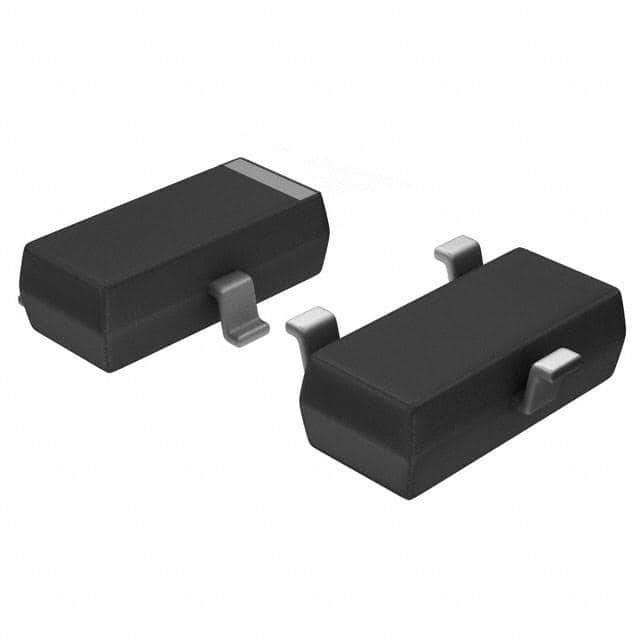Zie specificaties voor productdetails.

BCW30 Transistor: Encyclopedia Entry
Introduction
The BCW30 transistor is a crucial component in the field of electronics, belonging to the category of NPN bipolar junction transistors. This entry provides an overview of the BCW30 transistor, including its basic information, specifications, pin configuration, functional features, advantages and disadvantages, working principles, application field plans, and alternative models.
Basic Information Overview
- Category: NPN Bipolar Junction Transistor
- Use: Amplification and switching applications in electronic circuits
- Characteristics: High current gain, low noise, and low power dissipation
- Package: SOT-23
- Essence: Small signal transistor for general purpose amplification and switching
- Packaging/Quantity: Typically available in reels of 3000 units
Specifications
- Maximum Collector-Base Voltage (VCBO): 45V
- Maximum Collector-Emitter Voltage (VCEO): 45V
- Maximum Emitter-Base Voltage (VEBO): 5V
- Continuous Collector Current (IC): 100mA
- Power Dissipation (Ptot): 250mW
- Transition Frequency (fT): 250MHz
Detailed Pin Configuration
The BCW30 transistor has three pins: 1. Emitter (E): Connected to the N-type semiconductor material 2. Base (B): Controls the flow of current between the emitter and collector 3. Collector (C): Collects the majority charge carriers
Functional Features
- High current gain allows for small base current to control large collector current
- Low noise makes it suitable for audio amplifier applications
- Low power dissipation enables efficient operation in battery-powered devices
Advantages and Disadvantages
Advantages
- High current gain for amplification purposes
- Low noise performance for audio applications
- Small package size for space-constrained designs
Disadvantages
- Limited maximum collector current compared to power transistors
- Moderate power dissipation capability restricts high-power applications
Working Principles
The BCW30 operates based on the principles of bipolar junction transistors. When a small current flows into the base terminal, it controls a much larger current flowing between the collector and emitter terminals, allowing for amplification or switching of signals.
Detailed Application Field Plans
The BCW30 transistor finds extensive use in various electronic applications, including: - Audio amplifiers - Signal amplification in sensor circuits - Switching applications in digital logic circuits - Oscillator circuits in radio frequency applications
Detailed and Complete Alternative Models
Several alternative models to the BCW30 transistor include: - BCW31: Higher current gain variant - BCW32: Lower noise variant - BCW33: Higher power dissipation variant
In conclusion, the BCW30 transistor serves as a versatile component in electronic circuits, offering high current gain, low noise, and efficient operation in a compact package. Its applications span across audio amplification, signal processing, and digital logic, making it a valuable choice for various electronic designs.
Word Count: 411
Noem 10 veelgestelde vragen en antwoorden met betrekking tot de toepassing van BCW30 in technische oplossingen
What is BCW30?
- BCW30 is a high-performance silicon NPN bipolar junction transistor designed for use in RF and microwave applications.
What are the key features of BCW30?
- The key features of BCW30 include high transition frequency, low noise figure, and high power gain.
What are the typical applications of BCW30?
- BCW30 is commonly used in RF amplifiers, oscillators, mixers, and other high-frequency circuits.
What is the maximum operating frequency of BCW30?
- BCW30 has a maximum operating frequency of 8 GHz, making it suitable for many high-frequency applications.
What is the voltage and current rating of BCW30?
- BCW30 has a maximum collector-emitter voltage of 20V and a maximum collector current of 100mA.
What are the recommended operating conditions for BCW30?
- The recommended operating conditions for BCW30 include a collector current of 10mA to 50mA and a collector-emitter voltage of 5V to 15V.
Is BCW30 suitable for low-noise amplifier designs?
- Yes, BCW30's low noise figure makes it well-suited for use in low-noise amplifier designs.
Can BCW30 be used in high-power applications?
- No, BCW30 is not designed for high-power applications due to its limited collector current rating.
Are there any specific layout considerations when using BCW30 in a circuit?
- It is important to minimize parasitic capacitance and inductance in the layout to ensure optimal performance of BCW30.
Where can I find detailed application notes for using BCW30 in technical solutions?
- Detailed application notes for BCW30 can be found on the manufacturer's website or in the product datasheet.

